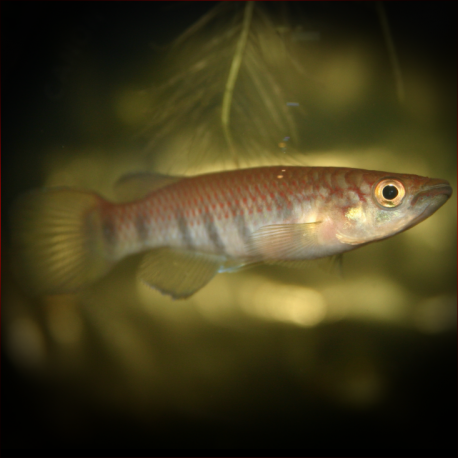Epiplatys Fasciolatus
Cyprinodontiformes Print
More info
Datasheet
| Minimum Tank Size | 96 litres / 25.36 US gallons |
| Maximum Size | 8.0cm / 3.15inches |
| Temperature | 20°C / 68.00°F - 27°C / 80.60°F |
| Hardness | 1.01dgH / 18ppm - 12.05dgH / 215ppm |
| pH | 5.0-7.0 |
General Description
The Banded Epiplatys, scientifically known as Epiplatys Fasciolatus, is a species of aplocheiloid toothcarp belonging to the family Nothobranchiidae. It is distinguished by thin, dark, transverse bars on its flanks, metallic blue or green pigmentation on the body and fins of males, and red submarginal bands on the anal and lower part of the caudal fins.
Aquarium Setup
For optimal display, the Banded Epiplatys thrives in a heavily-planted tank with a sandy substrate, driftwood roots, and branches. Adding dried leaf litter not only enhances the natural environment but also promotes microbe colonies that serve as additional food sources, especially for fry. Dim lighting is preferred, and suitable aquatic plant species include Microsorum, Taxiphyllum, and Anubias, with floating vegetation like Ceratopteris also appreciated.
Behaviour
Native to freshwater swamps and minor tributary streams, the Banded Epiplatys exhibits varied habitat preferences, from grassy savannah to rainforest environments. This species coexists with other fish species such as E. njalaensis and Scriptaphyosemion roloffi.
Feeding and Diet
The Banded Epiplatys is likely a predator in the wild, feeding on both terrestrial and aquatic invertebrates and zooplankton. In captivity, they accept dried foods but should be provided daily live or frozen fare like Artemia nauplii, Daphnia, and small insects such as crickets or fruit flies as part of their diet.
Reproduction & Dimorphism
Sexual dimorphism is evident in the Banded Epiplatys, with males displaying more coloration, extended fins, and larger size compared to females. The species engages in reproduction through typical killifish behavior, with males exhibiting courtship displays to attract females for spawning.
Habitat and Distribution
Endemic to northwestern Africa, the Banded Epiplatys ranges from Guinea-Bissau to western Liberia, encompassing areas like Sierra Leone and Monrovia. The species inhabits freshwater swamps, minor tributary streams, and occasionally grassy savannahs, cohabiting with sympatric fish species like E. njalaensis and Scriptaphyosemion roloffi.

